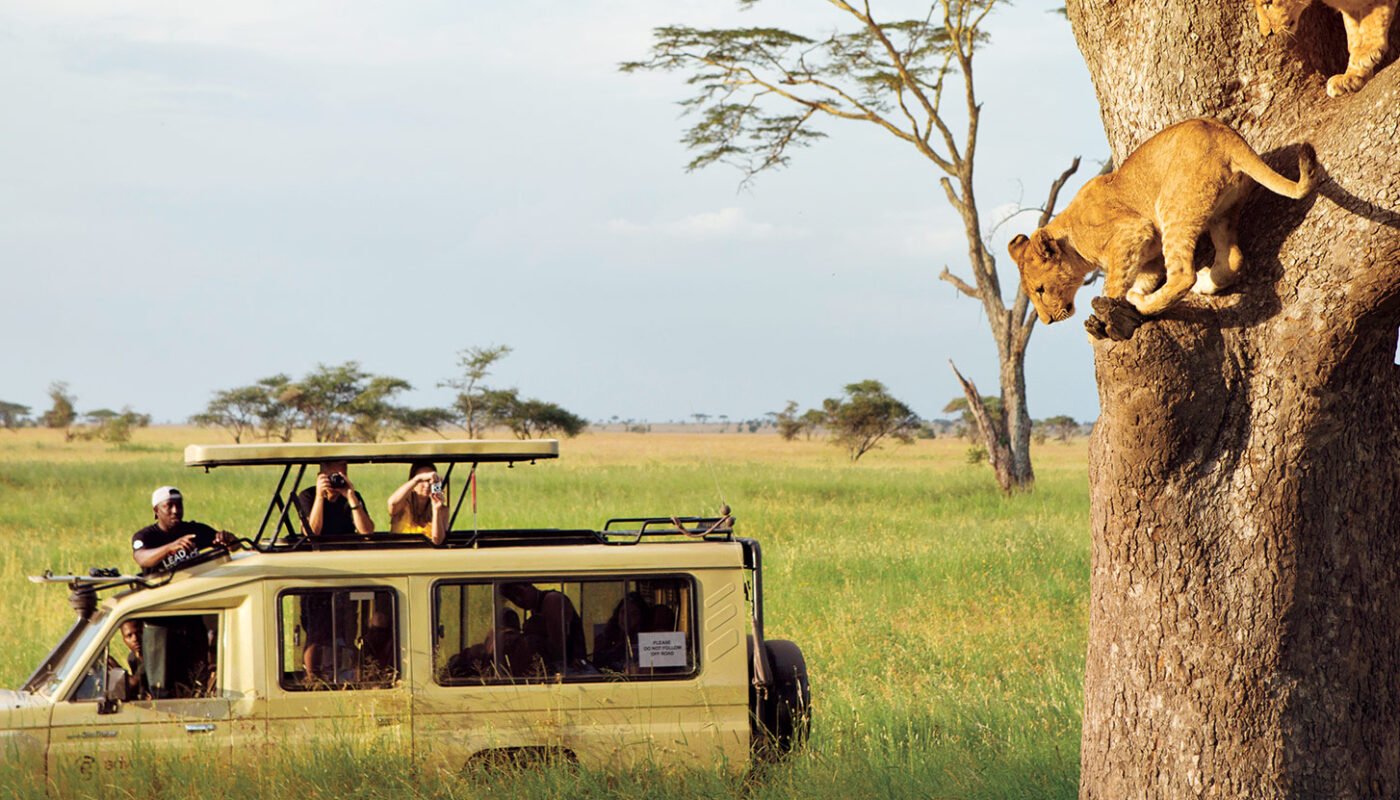When it comes to African safaris, Tanzania stands out as one of the most sought-after destinations. African Safari Tanzania: Known for its diverse landscapes, abundant wildlife, and rich cultural heritage, Tanzania offers an unparalleled safari experience that attracts adventurers from around the globe. From the iconic Serengeti National Park to the majestic Mount Kilimanjaro, Tanzania’s safari offerings are nothing short of extraordinary.
In this blog, we’ll explore why Tanzania should be at the top of your list for your next adventure. We’ll delve into the country’s unparalleled safari experiences, its diverse wildlife, and the unique cultural encounters that await you.
1. The Serengeti: A Safari Wonderland
A. The Great Migration
One of the most spectacular wildlife events on Earth, the Great Migration, unfolds in the Serengeti National Park. Every year, millions of wildebeest, zebras, and gazelles embark on a journey across the plains in search of fresh grazing grounds. This incredible spectacle, marked by dramatic river crossings and predator-prey interactions, is a must-see for any safari enthusiast.
The migration follows a predictable route, but the timing can vary slightly each year. The best time to witness this phenomenon is typically from June to October, when the herds are in the northern Serengeti and are making their way to the Maasai Mara in Kenya.
B. Serengeti’s Wildlife Diversity
The Serengeti is not just about the migration. It is home to a vast array of wildlife throughout the year. Visitors can expect to see:
- Lions: Often spotted resting in the shade or on a hunt.
- Elephants: Majestic herds roaming the grasslands.
- Cheetahs: Graceful hunters darting across the plains.
- Giraffes: Browsing on acacia trees.
- Hippos: Lazing in waterholes.
The Serengeti’s varied landscapes, from open grasslands to rocky outcrops, provide diverse habitats that support a rich tapestry of animal life.

2. Mount Kilimanjaro: Africa’s Highest Peak
A. A Climber’s Dream
Mount Kilimanjaro, the highest peak in Africa, is a bucket-list destination for many adventure seekers. Standing at 5,895 meters (19,341 feet), Kilimanjaro offers a range of trekking routes, from the relatively straightforward Marangu Route to the more challenging Lemosho and Machame Routes.
Climbing Kilimanjaro is a once-in-a-lifetime experience that takes you through various climatic zones, including lush rainforests, alpine meadows, and arctic deserts. The summit, Uhuru Peak, provides breathtaking views of the surrounding landscapes and is a testament to human endurance and achievement.
B. No Technical Climbing Required
One of Kilimanjaro’s unique features is that no technical climbing skills are required. The trek is a challenging hike, but it is achievable for those with a good level of fitness. Professional guides and porters provide support throughout the journey, making it accessible for a wide range of adventurers.
3. Ngorongoro Crater: A Natural Wonder
A. A World Heritage Site
The Ngorongoro Crater, a UNESCO World Heritage Site, is one of the most unique geological features in the world. Formed by a collapsed volcano, the crater is a vast caldera that houses a diverse array of wildlife within its fertile floor. The crater is approximately 20 kilometers (12 miles) in diameter and offers some of the best game-viewing opportunities in Tanzania.
B. Wildlife and Scenery
Inside the crater, you can find a variety of wildlife, including:
- Black rhinos: One of the crater’s rare residents.
- Buffaloes: Grazing in large herds.
- Elephants: Roaming freely across the plains.
- Lions: Preying on the abundant herbivores.
The lush grasslands and salt flats of the crater floor are contrasted by the surrounding escarpment, creating a stunning and diverse landscape.
4. Zanzibar: An Island Paradise
A. Pristine Beaches
Zanzibar, an archipelago off the coast of Tanzania, is renowned for its stunning beaches and turquoise waters. The island’s white sandy beaches, such as Nungwi and Kendwa, are perfect for relaxation and water activities.
B. Cultural Richness
Zanzibar’s Stone Town, a UNESCO World Heritage Site, is a fascinating blend of Swahili, Arab, Persian, and Indian influences. Wander through its narrow streets, explore the bustling markets, and visit historic sites like the House of Wonders and the Old Fort.
C. Spice Tours
Zanzibar is also known as the “Spice Island.” Spice tours offer an immersive experience into the island’s spice trade history, where you can see and smell a variety of spices, including cloves, nutmeg, and vanilla.
5. Tarangire National Park: An Elephant Paradise
A. Elephants and Baobabs
Tarangire National Park is renowned for its large elephant herds and iconic baobab trees. The park’s seasonal swamps attract elephants from across the region, making it one of the best places in Tanzania to see these majestic animals up close.
B. Diverse Wildlife
In addition to elephants, Tarangire offers excellent opportunities to spot:
- Giraffes: Moving gracefully through the park.
- Lions: Lurking in the tall grass.
- Leopards: Elusive and rarely seen.
The park’s varied habitats, from riverine woodlands to savanna, support a rich variety of wildlife.
6. Ruinsori Mountains: Tanzania’s Lesser-Known Gems
A. Untamed Beauty
The Ruinsori Mountains, located in the western part of Tanzania, offer a less-traveled alternative to Kilimanjaro. The rugged terrain, lush forests, and pristine lakes make it a haven for those seeking a more remote adventure.
B. Trekking Opportunities
Trekking in the Ruinsori Mountains provides a unique experience, with opportunities to explore volcanic landscapes, dense rainforests, and stunning alpine scenery. The area is less crowded than Kilimanjaro, offering a more solitary and immersive adventure.
7. Cultural Encounters and Local Communities
A. Maasai Villages
A visit to Tanzania wouldn’t be complete without experiencing the culture of the Maasai people. Maasai villages, located near many of Tanzania’s national parks, offer a chance to learn about their traditional way of life, including their unique customs, clothing, and ceremonies.
B. Authentic Experiences
Engage in cultural activities such as traditional dance performances, craft workshops, and local cooking classes. These experiences provide valuable insights into Tanzanian culture and help support local communities.
8. Practical Information for Your Safari Adventure
A. Best Time to Visit
The best time to visit Tanzania depends on your interests:
- For the Great Migration: June to October.
- For climbing Kilimanjaro: January to March and September to October.
- For beach relaxation in Zanzibar: June to October and December to February.
B. Health and Safety
Travelers should ensure they have the necessary vaccinations and take malaria prophylaxis. It’s also important to have travel insurance and follow local safety guidelines.
C. Accommodation Options
Tanzania offers a range of accommodation options, from luxury lodges and tented camps to budget-friendly hotels. Many lodges are strategically located to provide easy access to major wildlife areas and offer exceptional views of the surrounding landscapes.
Conclusion
Tanzania is an unparalleled destination for safari enthusiasts and adventure seekers alike. With its diverse landscapes, abundant wildlife, and rich cultural experiences, it promises a memorable adventure that caters to every type of traveler. Whether you’re marveling at the Great Migration in the Serengeti, summiting Mount Kilimanjaro, or exploring the vibrant cultures of Zanzibar, Tanzania offers an array of experiences that will leave you with lasting memories.
Embark on a journey to Tanzania and discover why this country should be your next safari adventure. With its stunning natural beauty and warm hospitality, Tanzania invites you to explore its hidden treasures and experience the thrill of an African safari like no other.

